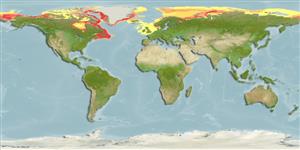Preferred temperature (Ref.
123201): -1.6 - 1.8, mean -0.6 °C (based on 2043 cells).
Phylogenetic diversity index (Ref.
82804): PD
50 = 0.5078 [Uniqueness, from 0.5 = low to 2.0 = high].
Bayesian length-weight: a=0.00759 (0.00470 - 0.01224), b=3.25 (3.11 - 3.39), in cm total length, based on LWR estimates for this species & (Sub)family-body (Ref.
93245).
Trophic level (Ref.
69278): 3.3 ±0.4 se; based on diet studies.
Resilienza (Ref.
120179): Medio, tempo minimo di raddoppiamento della popolazione 1.4 - 4.4 anni (tm=2-4; tmax=9; Fec=3,030).
Fishing Vulnerability (Ref.
59153): Low vulnerability (20 of 100).
Nutrients (Ref.
124155): Calcium = 48.9 [19.3, 113.2] mg/100g; Iron = 0.45 [0.20, 1.05] mg/100g; Protein = 16.6 [14.4, 18.8] %; Omega3 = 0.361 [0.142, 1.101] g/100g; Selenium = 18.9 [7.2, 48.8] μg/100g; VitaminA = 13.9 [2.9, 64.2] μg/100g; Zinc = 0.541 [0.342, 0.918] mg/100g (wet weight);
